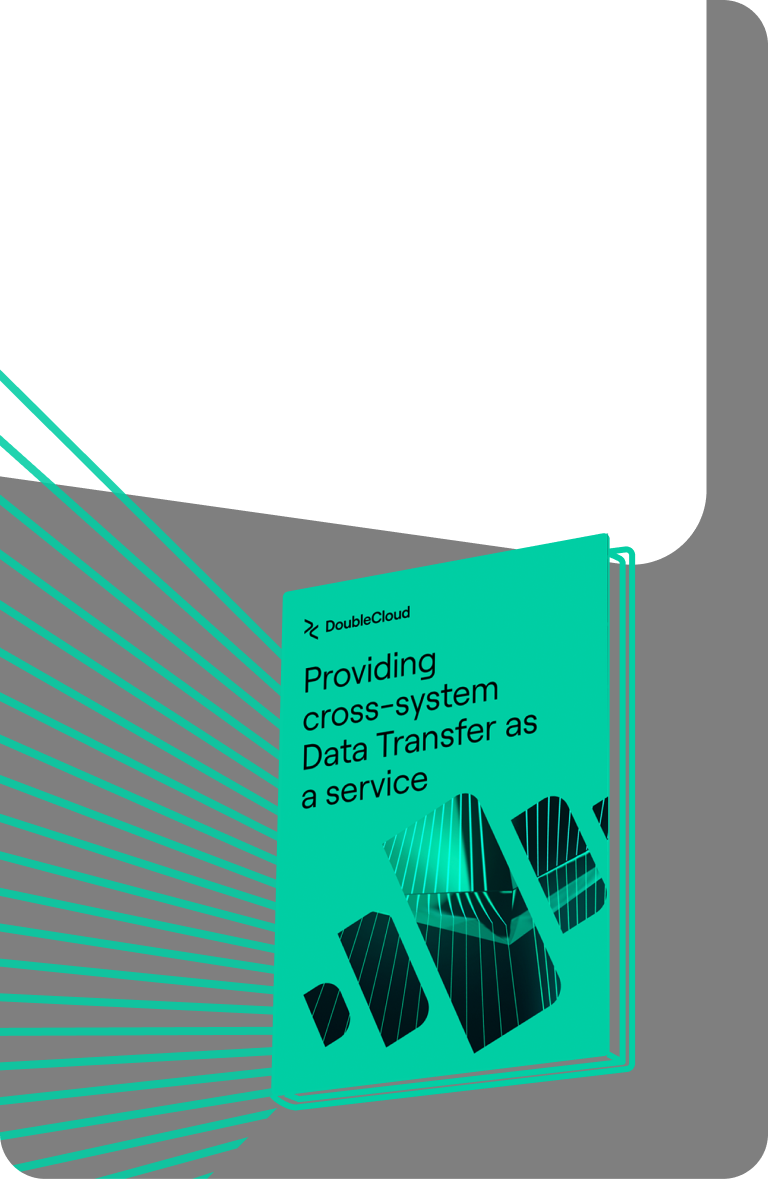
Data migration simplified: Types, cases & strategies
Data migration is a critical process in today’s data-driven world where data is constantly being generated with the need to transfer them from one location to another. There are many reasons why businesses may want to move their data to a different location or system which may include adopting new technologies, consolidating data, or transitioning to the cloud.
In this article, we will provide insights and information on the types of data migration, their importance, best practices, and challenges involved in the process.
What is data migration?
Data migration is the process of transferring any form of data from one system, storage location, or format to another while ensuring its integrity, security, and accuracy. It involves a series of well-defined steps from planning to extraction, validation, and transloading into the destination system to ensure a smooth and successful migration in the target format.
One of the major significance of data migration lies in its ability to empower organizations with up-to-date and reliable data that can enhance decision-making processes, improve operational efficiency, and drive business growth.

In this article, we’ll talk about:
- What is data migration?
- Importance of data migration for businesses
- Business cases that may require data migration
- Why is data migration seen as difficult and risky?
- Types of data migration
- Data migration challenges
- How to plan a data migration
- Best practices of data migration
- Post-migration activities
- Final words
- FAQ
Data migration vs. data conversion vs. data integration
Data migration, data conversion, and data integration are three terms you may hear whenever data management is being discussed. However, each process serves a unique purpose and has specific use cases.
Data migration as aforementioned focuses on transferring data from one storage site, system, or format to another. It can be a complex process, and organizations often use data migration tools to ensure integrity, accuracy, and security. The primary goal of data migration is to move data from its source system or format to a target system, often because of the need to upgrade technology, consolidate data, or transit to a better infrastructure.
Data conversion on the other hand refers to the process of changing data from one format or data structure to another. It involves transforming data from one format to another to ensure compatibility with the target system or application. This process is often required in data migration since it makes it possible for data to arrive at the new destination in a usable format.
Also, data integration involves combining data from multiple sources to get a unified and coherent view. It provides a holistic and comprehensive understanding of the data, which enables businesses to make better decisions and improve business processes.
Importance of data migration for businesses
Data migration is important to small and medium-sized businesses because it improves data accessibility, enabling informed decision-making, for business growth and scalability. Furthermore, it helps reduce the cost and strengthen the chances of seamless data recovery in the event of a loss or security breach. SMBs can optimize business processes, gain flexibility, and adapt to market changes by leveraging cloud data migration. Consolidating data in a central location streamlines workflows, leading to increased efficiency and productivity. This process empowers SMBs to harness real-time insights, stay competitive, and drive growth in a dynamic business landscape.
Business cases that may require data migration
Migration from ElasticSearch to Clickhouse
When migrating data from ElasticSearch to ClickHouse it is necessary to address the challenges posed by growing data volumes. ClickHouse, being a columnar database, is optimized for such high-performance analytical queries and provides efficient storage of large datasets. Take for example a scenario where a web analytics company currently using ElasticSearch to store and analyze real-time user behavior data on their website experience an increase in data volume. As the company’s user base grows, the volume of data increases significantly, leading to performance bottlenecks and higher storage costs. By migrating their data to ClickHouse the company can maintain real-time analytics capabilities while benefiting from faster query processing and cost-effective storage.
Migration from Druid to Clickhouse
Data migration from Druid to ClickHouse is essential for businesses looking to manage their growing data volume and analytical demands. While Druid excels at real-time ingestion and aggregation of data, ClickHouse’s columnar storage and compression techniques offer higher data compression and faster query processing. Take for example an e-commerce platform using Druid as its data store to support fast business aggregations and monitor sales and inventory data on real-time dashboards. However, because of the need to expand its product offerings and geographical reach, which will result in a massive increase in data ingestion and analytical queries, ClickHouse would be a better option. Migrating data to ClickHouse will allow the e-commerce platform to maintain real-time business analytics while achieving better performance and cost-efficiency as the business scales.
Why is data migration seen as difficult and risky?
Data migration is considered too risky due to the complexity of the process and the impediment it causes to business operations. Since it involves the transfer of useful data from one system or format to another, operations that require data insights may have to be halted until the migration is complete. Additionally, if the migration is not executed properly, it can result in data loss, corruption, or downtime.
Since the data may exist in different structures, formats, or applications, the migration process requires careful planning and execution making transformation and mapping challenging. Additionally, the migration process must ensure data quality, security, and compatibility between the source and target systems. Migrating vast amounts of data, especially in critical systems like data centers, requires specialized expertise, data migration tools, and strategies to achieve a successful and smooth migration without disrupting business processes.
Types of data migration
The following are the various types of data migration, their significance to data management, and their application in business scenarios.
Storage migration
Storage migration involves transferring data from one storage system or device to another. This procedure is crucial for businesses that need to upgrade their hardware, deal with storage capacity constraints, or optimize storage performance. Storage migration reduces data loss or corruption by ensuring data is accessible and secure during the transfer. Businesses can accommodate growing data volumes or make the switch to more cutting-edge storage solutions while still maintaining data continuity and performance.
Database migration
Moving data and its associated schema from one database management system (DBMS) to another is referred to as database migration. When upgrading to a newer version of the same DBMS, consolidating databases, or switching to a completely different database platform, businesses may choose database migration. To maintain data integrity and minimize downtime, this process necessitates careful planning and execution. Database migration enables businesses to take advantage of advanced database features while also improving performance and data management capabilities.
Application migration
Application migration involves transferring applications and the data they contain from one environment to another. This can happen when companies adopt new technologies, switch hosting providers, or migrate to cloud-based infrastructures. Application migration ensures the continuity of business services while capitalizing on the advantages of the new environment. Comprehensive testing and validation are required to ensure that the applications perform optimally in the new configuration.
Data center migration
The movement of an entire data center, including its infrastructure, hardware, and data, to a new physical location is known to as data center migration. Businesses may migrate their data centers as a result of business expansion, cost optimization, or disaster recovery planning. To ensure uninterrupted operations, this complex process requires careful planning, risk assessment, and downtime minimization. Businesses can improve their scalability, reliability, and disaster recovery capabilities by migrating their data centers.
Business data migration process
Business process migration entails moving business processes and the data associated with them from one system or environment to another. This can occur during the installation of new software, the adoption of integrated platforms, or the streamlining of operations. By optimizing workflows and data utilization, the goal is to increase business efficiency and productivity. To ensure a smooth transition, business process migration necessitates close collaboration between IT and business stakeholders.
Cloud migration
Moving data, applications, and IT resources from on-premises infrastructure to cloud-based environments is a type of data migration process referred to as cloud migration. Cloud migration may be chosen by businesses to achieve cost savings, scalability, and global accessibility. This procedure entails data transfer, application reconfiguration, and cloud data security. Cloud migration enables businesses to take advantage of advanced features offered by cloud providers such as auto-scaling and managed services while reducing the need for on-premises hardware maintenance.
Data migration challenges
Data migration, being a complex process, presents various challenges to businesses. Below we will highlight these constraints and challenges businesses may face when migrating data.
Data quality and integrity
Maintaining data quality and integrity is a significant challenge during data migration because data may exist in multiple formats or structures, resulting in transfer complexities and potential data errors. If improperly migrated, Inaccurate or corrupted data during migration can have a negative impact on business decisions and operations. It is imperative to ensure data accuracy throughout the migration process by using proper validation, cleansing, and verification mechanisms.
Downtime and business continuity
Data migration often involves downtime, which disrupts data access and operations. Downtime must be kept to a minimum in order to maintain business continuity and avoid revenue loss. To reduce downtime and ensure a smooth transition, businesses must be ready to carefully plan migration schedules, perform rigorous testing, and implement strategies such as parallel testing.
Security and privacy concerns
Data migration can sometimes present security and privacy issues, particularly when sensitive data is involved. When data is transferred across networks or third-party systems, it is vulnerable to security breaches. To protect sensitive information, strong encryption, and data masking techniques must be employed. Data protection regulations must be followed in order to maintain data security and privacy during migration.
Compatibility and data format issues
Data migration entails moving data between systems, and compatibility issues can arise due to differences in data formats and structures. It is critical to ensure seamless data translation and transformation between source and target systems to avoid data loss or corruption. To effectively address such compatibility issues, the right data migration tools and expertise are required.
Cost and resource constraints
Data migration is often resource-intensive and can result in unexpected costs. To ensure successful migration within budget constraints, businesses must allocate adequate resources, including skilled personnel and data migration tools. Adequate preparation, data set planning and prioritization can help optimize resource usage and lower migration costs.

DoubleCloud Managed Service for ClickHouse
An open-source, managed ClickHouse DBMS service for sub-second analytics. Don’t take two days to set up a new data cluster. Do it with us in five minutes.
How to plan a data migration
Businesses can plan their migration using the following steps to ensure a well-executed and successful data migration that minimizes risks, maximizes efficiency, and aligns with their strategic objectives.


Ebook
Providing cross-system Data Transfer as a service
Assessing data and infrastructure
-
Conduct a comprehensive inventory of data sources and formats to understand the scope of the migration.
-
Identify dependencies and relationships between data elements and applications.
-
Assess the current infrastructure’s capacity and capabilities to determine if upgrades or additional resources are needed.
-
Analyze data quality and identify areas that require improvement before migration.
-
Identify potential challenges, such as data compatibility issues or security concerns, and devise mitigation strategies.
Establishing clear objectives and goals
-
Collaborate with key stakeholders to define specific migration objectives aligned with the overall business strategy.
-
Set measurable goals, such as minimizing downtime, ensuring data integrity, and achieving cost-effectiveness.
-
Prioritize data sets based on business criticality to determine the order of migration.
-
Define success criteria, including data accuracy, minimal disruptions, and achieving migration timelines.
Building a data migration strategy
-
Develop a detailed data migration plan that outlines the migration process step-by-step.
-
Select appropriate migration methods based on data volume, complexity, and business requirements (e.g., big bang migration or phased migration).
-
Employ data migration tools and software platforms that align with the organization’s needs and facilitate seamless data transfer.
-
Implement data transformation and mapping techniques to ensure data compatibility between source and target systems.
-
Establish risk management protocols to address potential data loss or corruption during migration.
Setting realistic timelines
-
Set achievable milestones and deadlines for each phase of the data migration project.
-
Consider dependencies between data sets and applications when defining timelines.
-
Allocate sufficient time for testing and validation to identify and rectify issues before full migration.
-
Involve data migration specialists who have experience in similar projects to provide realistic estimates.
-
Regularly monitor progress and adjust timelines if necessary, while keeping stakeholders informed throughout the process.
Best practices of data migration
Businesses can execute data migration projects more effectively, mitigate risks, and achieve successful outcomes that align with their strategic goals by following these best practices.
Data backup and disaster recovery plan
Before beginning data migration, create a solid data backup and disaster recovery plan. Backing up the source data frequently ensures its safety in the event of any issues during migration. Furthermore, have a well-defined disaster recovery strategy in place to recover data if it is lost or corrupted. This procedure ensures business continuity and reduces the possibility of data loss during migration.
Data mapping and transformation
Data mapping and transformation are critical components of any data migration process as it ensures compatibility between source and target systems. Analyze both systems' data structures and formats and map data attributes to their corresponding fields in the new environment. Performing data transformation is a required process to meet the requirements of the target system. This practice ensures that data is accurate and complete after migration.
Data validation and testing
To ensure the accuracy and integrity of the migrated data, businesses should perform extensive data validation and testing. Validating data against the source system ensures that it has been transferred and transformed correctly. Before performing a full migration, conduct testing in a controlled environment to identify and resolve any issues. Data validation and testing instill confidence in the quality of the data and reduce the likelihood of errors in the new system.
Incremental migration vs. Big Bang approach
Incremental migration entails migrating data in stages, which reduces disruptions but takes longer to complete. On the other hand, the big bang method transfers all data at once, which results in less downtime but potentially higher risks. When deciding between the two methods, consider factors such as data volume, complexity, and the organization’s tolerance for downtime.
Involving stakeholders and end-users
Involve stakeholders and end users in the migration process to learn about their needs and expectations. Collaborate with them to gather feedback and address concerns during the planning and testing phases. This method ensures that the migration aligns with business objectives while minimizing disruptions to end users, resulting in a more seamless transition to the new system.
Post-migration activities
To ensure that the data migration project is completed and wrapped up properly, businesses should do these post-migration activities for improved data accuracy, optimal system performance, and a seamless transition to the new environment.
Data validation and quality checks
It is essential to perform post-migration data validation and quality checks to guarantee the migration process’s success. Check that all data has been correctly migrated and transformed to the new environment. Validate the data against the source system to ensure its accuracy and consistency. Perform data quality checks to identify any discrepancies or errors that may have occurred during migration. Businesses can then confidently rely on the migrated data for critical decision-making and operational processes.
Performance monitoring and optimization
After migration, closely monitor the new environment’s performance to identify potential bottlenecks or areas that require optimization. To ensure that the new environment meets performance expectations, monitor data processing times, query performance, and system response. Improve data retrieval and processing efficiency by optimizing database configurations, indexes, and caching mechanisms. Monitor performance metrics on a regular basis to address any performance issues and ensure a smooth user experience.
Addressing post-migration issues
Even with the most meticulous planning, post-migration issues may arise. Create a post-migration support team comprised of data migration specialists and IT personnel to address any issues as soon as possible. Prioritize issues based on their impact on business operations and resolve them in a systematic manner. Maintain open lines of communication with stakeholders and end users in order to collect feedback and address any issues as soon as possible. Document the lessons learned and apply them to future migration projects.
Final words
Data migration is a complex but necessary process for companies looking to optimize their data infrastructure, improve decision-making, and achieve scalability. To ensure data accuracy and system performance, successful data migration necessitates meticulous planning, validation, and post-migration optimization. Consider using Double.Cloud’s advanced data migration tools and expertise to streamline this critical process and overcome data challenges. Businesses can confidently navigate their data migration journey with Double.Cloud, ensuring seamless transitions, robust data quality, and the achievement of their strategic objectives. Take advantage of Double.Cloud for your data needs and maximize the value of your valuable data.

DoubleCloud Transfer
A cloud agnostic service for aggregating, collecting, and migrating data from various sources.
Frequently asked questions (FAQ)
Is there a difference between data transfer and data migration?
Is there a difference between data transfer and data migration?
Yes, there is a distinction between data transfer and data migration. The process of moving data from one location or system to another that does not necessitate significant changes in the data structure or format is referred to as data transfer. Data migration, on the other hand, entails not only transferring data but also transforming and adapting the data to fit the structure of the target system, ensuring seamless compatibility and successful integration.
What is the main goal of data migration?
What is the main goal of data migration?
Who is responsible for data migration?
Who is responsible for data migration?
Get started with DoubleCloud



